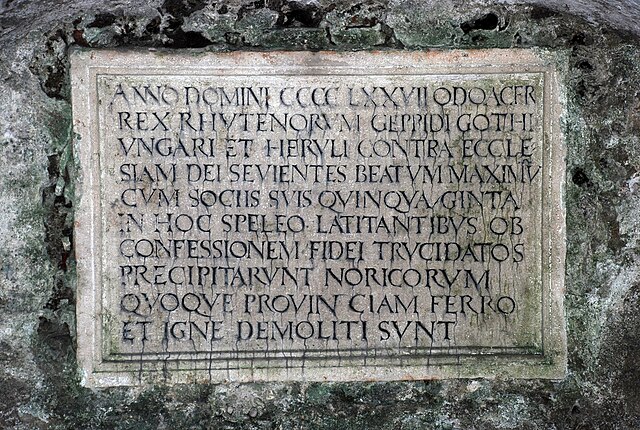Odoacer, also spelled Odovacer or Odovacar, was a barbarian soldier and statesman from the Middle Danube who deposed the Western Roman child emperor Romulus Augustulus and became the ruler of Italy (476–493). Odoacer's overthrow of Romulus Augustulus is traditionally understood as marking the end of the Western Roman Empire.
Latin memorial plate from 1521, that mentions Odoacer as Rex Rhutenorum (Petersfriedhof, Salzburg)
Romulus Augustus resigns the Crown (from a 19th-century illustration).
Odoacer solidus struck in the name of Emperor Zeno, testifying to the formal submission of Odoacer to Zeno
An early illustration of a mythologized Theodoric killing Odoacer in a joust. From the Chronica Theodericiana (1181).
The term Western Roman Empire is used in modern historiography to refer to the western provinces of the Roman Empire, collectively, during any period in which they were administered separately from the eastern provinces by a separate, independent imperial court. Particularly during the period from AD 395 to 476, there were separate, coequal courts dividing the governance of the empire into the Western provinces and the Eastern provinces with a distinct imperial succession in the separate courts. The terms Western Roman Empire and Eastern Roman Empire were coined in modern times to describe political entities that were de facto independent; contemporary Romans did not consider the Empire to have been split into two empires but viewed it as a single polity governed by two imperial courts for administrative expediency. The Western Empire collapsed in 476, and the Western imperial court in Ravenna disappeared by AD 554, at the end of Justinian's Gothic War.
Gold solidus of Honorius
Boxwood relief depicting the liberation of a besieged city by a relief force, with those defending the walls making a sortie. Western Roman Empire, early 5th century AD
6th-century Visigothic coin, struck in the name of Emperor Justinian I
Odoacer's Italy in AD 480, following the annexation of Dalmatia








